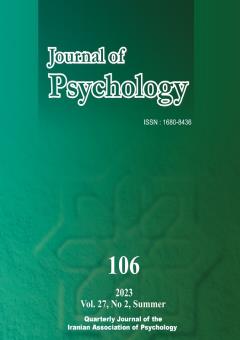Choosing the most suitable personality questions in the measurement of personality dimensions: combining the latent trait theory and network data analysis
Subject Areas : PsychologyMaryam Mohtashami 1 , Mohammad Hossein Zarghami 2 , Beheshteh Niooshah 3
1 - Islamic Azad University Saveh branch
2 - Department of Behavioral Sciences, Life Style Institute, Baqiyatallah University of Medical Sciences, Tehran, Iran.
3 - Psychology department-Islamic Azad university-Saveh branch
Keywords: Personality, psychometrics, correspondence analysis, network, dimensionality, data, personality assessment,
Abstract :
The word personality refers to the uniqueness, individuality and subjectivity of the subject being studied. The measurement of such a dynamic and complex concept is considered a fundamental challenge in the field of methodology for the measurement of psychological constructs. The aim of this research is to present a new method in two different parts of personality questionnaire question analysis: a) personality questionnaire question dimensions obtained from the implementation of questionnaires on independent samples through correspondence analysis and b) question prioritization using from the network data analysis method based on the importance of questions in each dimension. To achieve these goals, 32 personality questionnaires - which cover most of the application areas of personality questionnaires - were implemented on 82,988 volunteers via web-based forms. Correspondence analysis results show that personality has two dominant dimensions that explain about 75% of personality variance. The results of network data analysis show that the important questions in different indexes are not necessarily the same and the selection of questions based on a specific index should be based on the meaning of that index, however, according to the correlation structure of the priority of questions in the index network, a general index was defined based on which questions were prioritized in two dimensions of personality. The result of the present research led to the presentation of an algorithm for selecting personality questions in personality dimensions.
پاکیزه، علی؛ حکمتیانفرد، صادق؛ منصورزاده، سارا. (۱۴۰۱). تأثیر بار شناختی بر اعتماد به دیگران: بررسی نقش تعدیلگر تعالی شخصیت. مجله روانشناسی.۲۶(۲)، ۱۳۰-۱۳۹ .
چلبي مسعود(1375)، تحليل شبكه در جامعه شناسي، فصلنامه علوم اجتماعي، شماره 3.
حاجحسینی، شادی؛ فتی، لادن؛ فتحیآشتیانی، علی. (۱۴۰۱). ویژگیهای روانسنجی و ساختارعاملی نسخه فارسی مقیاس اعتیاد به گوشی هوشمند. مجله روانشناسی،۲۶(۱)،۲۴-۳۴.
شاملو، سعید، مکتب ها و نظریه ها در روانشناسی شخصیّت، تهران، رشد، انتشارات رشد، 1390.
ضرغامی، محمد حسین؛ دلاور، علی؛ فلسفی نژاد، محمد رضا؛ درتاج، فریبرز؛ و خوش سخن مظفر، اکرم. آزمون کاربرد تحلیل داده های شبکه ای در مطالعات همبودی، اندازه گیری تربیتی، شماره 50.
ضرغامی، محمد حسین؛ قائمی، فرحناز؛ قائمی، فاطمه، برآورد استعداد افراد در فعالسازی ژن ها، ژنتیک در هزاره سوم، دوره 11، شماره1.
ولیپور، محمد؛ شیدعنبرانی، بهناز؛ داودی، فاطمه. نقش صفات مرضی شخصیت، طرحوارههای ناسازگار اولیه و طرحوارههای هیجانی در پیشبینی اختلالات شخصیت خوشه B، مجله روانشناسی.۲۶(۱)،۷۶-۹۰
Beh, E. J., & Lombardo, R. (2019). Multiple and multiway correspondence analysis. Wiley Interdisciplinary Reviews: Computational Statistics, 11(5), e1464.
Brandes, U. (2001). A faster algorithm for betweenness centrality*. Journal of Mathematical Sociology,25(2), 163-177.
Epskamp, S., Borsboom, D., & Fried, E. I. (2018). Estimating psychological networks and their accuracy: A tutorial paper. Behavior research methods, 50, 195-212.
Epskamp, S., Cramer, A. O. J., Waldorp, L. J., Schmittmann, V. D., & Borsboom, D. (2011).qgraph: Network representations of relationships in data. R package version 0.4.10.
Fortunato, S. (2010). Community detection in graphs.Physics Reports,486(3), 75-174.
Jobson, J. D. (1992). Principal components, factors and correspondence analysis. In Applied multivariate data analysis (pp. 345-482). Springer, New York, NY
Kutscher, E. L., & Howard, L. C. (2022). Integration as a process: Applying iterative multiple correspondence analysis to surface dynamic findings. Journal of Mixed Methods Research, 16(3), 328-349.
Newman, M. E. (2006). Modularity and community structure in networks. Proceedings of the National Academy of Sciences, 103(23), 8577-8582.
Pham, S. T., & Sampson, P. M. (2022). The development of artificial intelligence in education: A review in context. Journal of Computer Assisted Learning, 38(5), 1408-1421.
Reckase, M. D., & Hirsch, T. M. (1991). Interpretation of Number-Correct Scores when the True Number of Dimensions Assessed by a Test Is Greater than Two.
Riff, D., Lacy, S., & Fico, F. (2014). Analyzing media messages: Using quantitative content analysis in research. Routledge.


